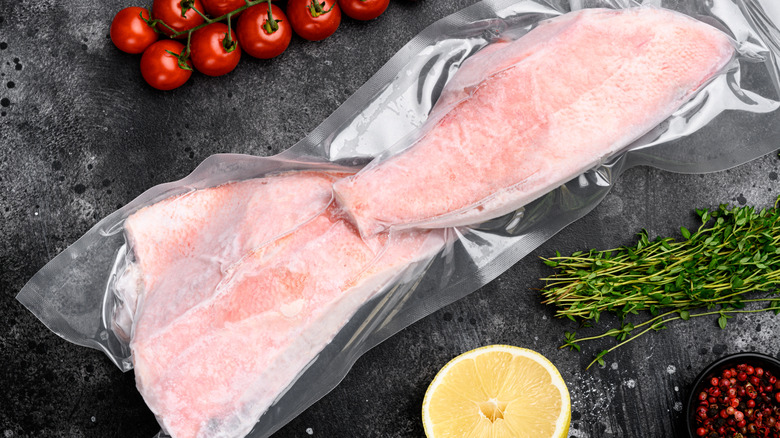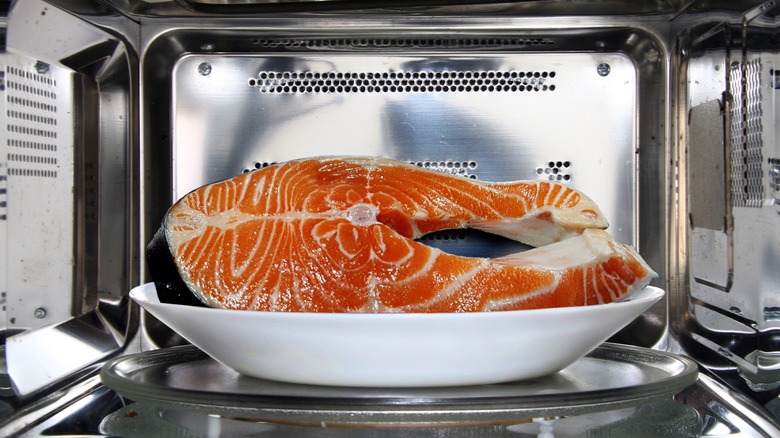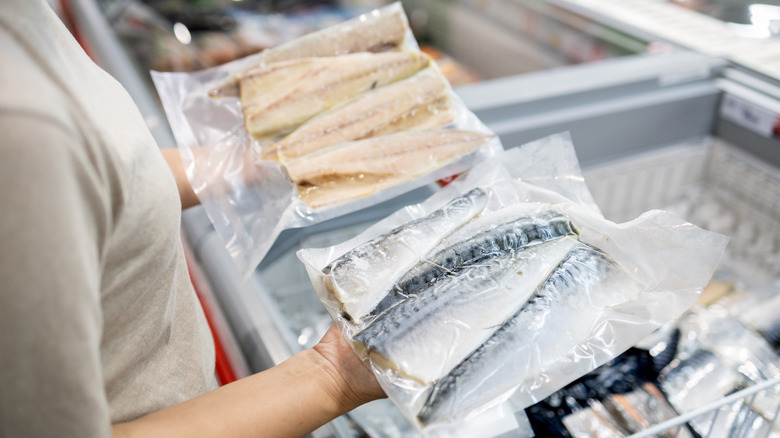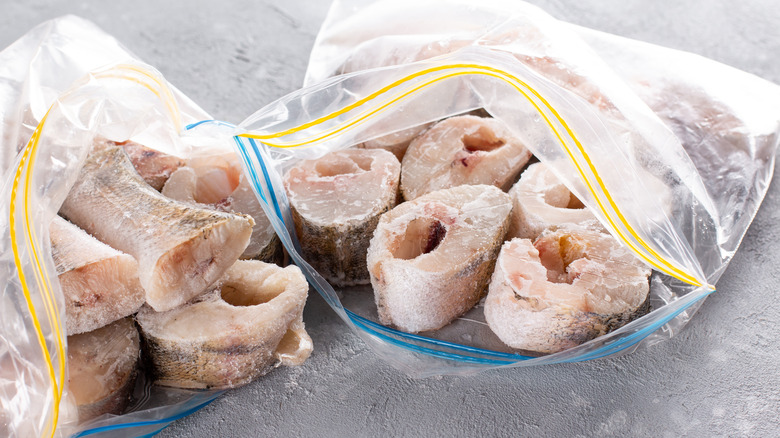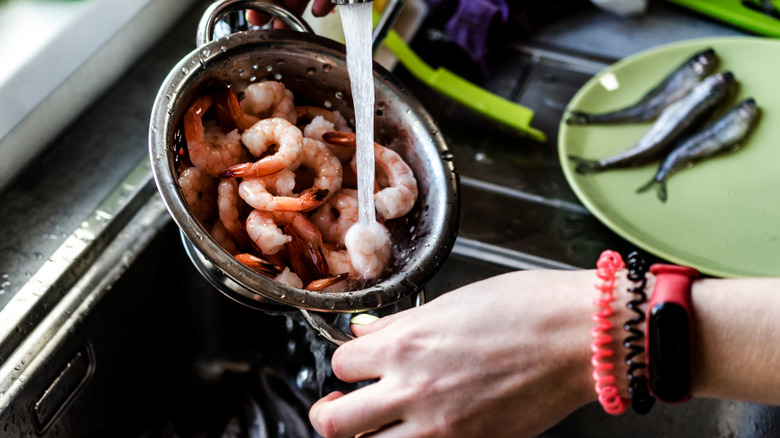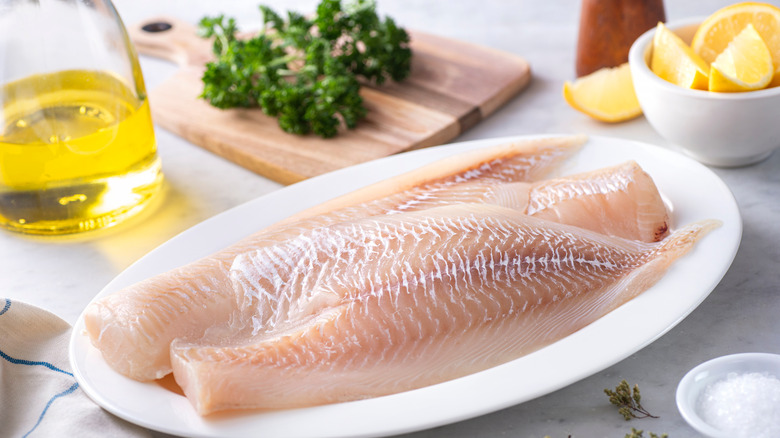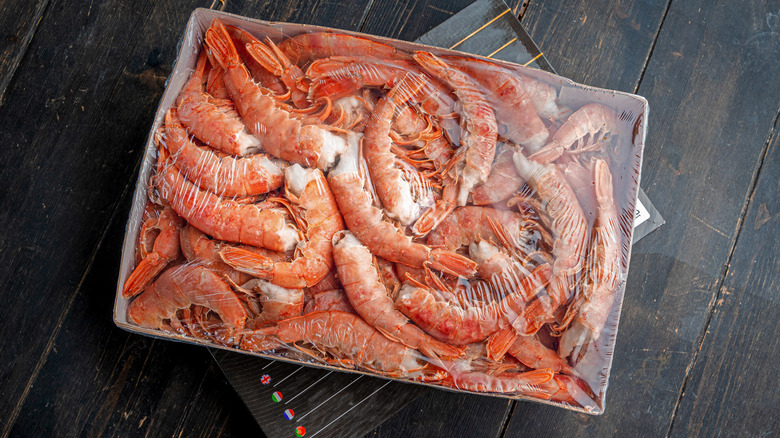10 Major Mistakes To Avoid When Defrosting Seafood
Contrary to popular belief, frozen seafood can be incredibly worthwhile. Frozen fish has long had a bad rap, but it is finally having its moment in the spotlight. Fish that get flash-frozen at peak condition allows people who don't live near coasts to have access to quality seafood. Frozen salmon, for example, can be just as good if not better than fresh, especially when you consider how long it takes fresh fish to get to the supermarket and into your kitchen.
Frozen fish certainly has a longer shelf life than fresh, and when you defrost high-quality seafood, it should feel like it was never frozen. To preserve the fish's condition, how you defrost seafood is just as important as how it was frozen. A lot can go wrong when defrosting, from ruining the fish to causing food poisoning. These are the most common mistakes people make when they thaw seafood. To help understand why these blunders are so important to avoid, we spoke with a food safety expert. Martin Bucknavage is the Senior Food Safety Extension Associate at the Penn State Extension Department of Food Science, and he is here to guide you towards better defrosting habits.
Not following FIFO
There is an important rule in food service called FIFO that promotes food safety and quality. Bucknavage explains that this acronym stands for "first in, first out," meaning that you use food based on use-by-dates or the date purchased. If you ever step into a commercial kitchen, you'll hopefully see all food storage containers clearly marked with dates. According to our expert, these demarcations are crucial in ensuring "the older product is used first."
Home kitchens don't have the same pressing need to follow food safety rules, but you probably use FIFO all the time. You wouldn't open a new carton of milk if you still have some you bought last week that is still in good shape. FIFO is essentially a common sense rule that we follow without realizing it. This term is most often discussed with refrigerated foods, but it is applicable to any stored food, including in your freezer.
Bucknavage attests that FIFO is very important for frozen fish. "Product in the freezer does continue to lose quality over time, especially fish which has oil that will be prone to oxidation, and skin open to freezer burn." Try to plan your meals around the fish that has been in your freezer the longest. USDA recommends using frozen fin fish within 3 to 8 months and up to 12 months for shellfish. Before you reach for that next pack of seafood in your freezer, consider getting rid of anything older than a year.
Defrosting at room temperature
Who among us can't recall this very occurrence as a core memory from your youth? You're sitting at home watching TV when your mom calls. She wants you to pull a package of meat out of the freezer and put it in the sink until she gets home. This seemingly universal experience, as it turns out, is not a good practice. It can actually be quite dangerous.
An important rule of food safety is to never thaw food at room temperature. Bucknavage spells out what happens when you leave fish on the countertop or in the sink to thaw. "This opens the outer portions to bacterial growth, and seafood is an item that will be more prone to that due to its natural makeup as well as native bacterial levels." When fish is not properly refrigerated, you are at risk of developing scombroid poisoning, according to the CDC, which mimics an allergic reaction but is a foodborne illness actually caused by temperature abuse.
Instead of thawing seafood at room temperature, Bucknavage states the safer methods are leaving fish in the refrigerator overnight to defrost or running it under cool water. He prefers the latter, which is speedier.
Thawing in warm water
Bucknavage illustrates in more detail why he goes for thawing seafood in cool water instead of overnight in the fridge. The short answer is time. He states you want to "keep the fish cold until you cook and cook it sooner rather than later." Since fish is not cheap, Bucknavage's preferred method is the quickest and allows you to keep fish in the freezer until shortly before cooking.
The key to this method, however, is temperature. You should never thaw food in warm water. Running cool water to thaw fish is perfectly safe, but warm water is not. You might think warm water will get the job done faster, but there can be consequences. When perishable food rises above 40 degrees Fahrenheit, it has officially entered the temperature "danger zone," where bacteria multiply more rapidly, making it more at risk of causing illness (via USDA). As Bucknavage clarifies, "We do not want to heat the fish up in any way that will support bacterial growth or to cause any changes to the fish."
Cool water is a great way to maintain the quality of your frozen seafood, and you won't have to worry about forgetting to pull it out of the freezer the night before. Submerge the package of fish in cool water and replace the water about every 30 minutes until it's defrosted. You can accomplish this in under an hour for standard one-pound packs of most seafood items.
Using the microwave
A common thawing process people use when they forget to defrost their food beforehand is using the microwave. Like other foods, defrosting seafood in the microwave can be safely done under specific circumstances. Bucknavage explains, "If you do thaw in the microwave, you have to finish cooking it immediately. You cannot place it back in the refrigerator because of hot spots that may have been generated in the meat." Again based on USDA guidance, when seafood begins to cook in the microwave while thawing, it leaves the outer part of the fish in the temperature danger zone. You'll need to cook it right away so it can reach an internal temperature of at least 140 degrees Fahrenheit, the upper limit of the danger zone.
Even if you safely defrost seafood in the microwave, we generally don't recommend it, as it can affect quality. Bucknavage adds, "A bigger issue from a quality perspective is that with microwave thawing, you may begin cooking the meat...and then if you do a cooking procedure after thawing, you may end up with overcooked fish." Simply put, overcooked seafood is unpleasant. If you are in an extra hurry and need to use the microwave, make sure to use caution. Set the microwave to 30% power and heat in 30-second increments until it is thawed, which will take 5 minutes or less. Rotating the fish every 30 seconds will help get a more even defrost.
Defrosting fish in vacuum-sealed packages
One of the best technologies that have improved the quality of frozen fish is the vacuum sealer. By sucking all of the air out of the bag and creating a "vacuum," these machines help prevent freezer burn. You can store vacuum-sealed seafood in the freezer for much longer than items in loose packaging. However, there is a little-known danger that comes with this technology.
Many people might assume that since it is safe to store fish in vacuum-sealed packages in the freezer, the same would be true for the fridge. This is not the case. On this matter, Bucknavage expresses the dangers of leaving thawed fish in vacuum-sealed packages. "The reason is related to specific strains of Clostridium botulinum that are associated with seafood," he says. "These strains need the lack of oxygen, which is where vacuum package comes in, and can grow at refrigeration temperatures." Clostridium botulinum is the bacteria that causes botulism, an illness you'll want to avoid if possible (via CDC).
To protect yourself from this serious illness, remove frozen fish from its vacuum package if you are going to defrost it overnight in the fridge. You can leave it in the bag for the cool water method, but you should take it out of the package as soon as it is thawed.
Defrosting fish directly in water
If you are finding that your frozen fish is mushy after it is cooked, you are probably making this critical defrosting mistake. Submerging frozen fish in water without the protection of sealed packaging can cause your seafood to get water-logged, greatly impacting the quality.
Bucknavage confirms that defrosting bare fish fillets directly in water "can add too much moisture to the fish." While he does say this is not such a problem for items like shrimp, it should be avoided for fin fish like salmon. He notes, "Keeping it in the package when thawing under running water will provide the best quality experience." You'll generally be in the clear if you are defrosting fish in vacuum-sealed or other commercial packaging, as long as there aren't holes in the bags. You'll want to be more careful with zip-top bags, as they tend not to seal securely. Fish that is wrapped in plastic and not in sealed bags are also not ideal for the cool water defrosting technique.
Not allowing shrimp to drain
One of our best tips for frozen seafood is to thaw shrimp in a colander. Shrimp naturally contain a lot of liquid, with one study stating their composition is 80% water (via NIH). You probably notice that bags of frozen shrimp tend to collect a pool of water while defrosting. When shrimp sit in liquid for too long, it can cause them to turn mushy during cooking. You can prevent this by placing frozen shrimp in a colander over a bowl and setting it in the fridge to defrost overnight. The colander will drain the water as the ice melts from the shrimp, allowing you to pat the shrimp dry before cooking and get a good sear.
Our food safety expert supports using this technique, but this approach is mostly a matter of quality. Bucknavage confirms it is a good idea to drain frozen shrimp to prevent it from sitting in its own liquid, although he adds that doing this can also aid with the thawing process. If you are in a rush to thaw shrimp, you can empty the package into a colander and run cold water over them. The cool water will help melt the ice and allow any shrimp that clumped together to break apart. Given the size of most shrimp, the whole process will take less than 10 minutes.
Defrosting too early
One of the biggest difficulties with buying fresh fish is that it puts pressure on you to cook it quickly. USDA states you should only keep fresh seafood in the fridge for 1-2 days before you cook or freeze it. That's where frozen fish offers you more flexibility. You can't buy fresh fish at the market on Saturday if you don't have plans to cook until Wednesday.
Since seafood can be stored in your freezer for extended periods, there is no need to defrost fish any earlier than the evening before you plan to cook. Sometimes plans change, and you need to rearrange your weekly cooking schedule, which is perfectly fine. Just try your best to cook the seafood on the second, so you don't miss out on its peak quality. Bucknavage agrees with the USDA recommendation of storing fish for only 1-2 days. As he puts it, "It is best to use it as quickly as possible," which is why he likes to defrost in cool water just before cooking.
Cooking from frozen
The official guidance from USDA offers four methods for safely thawing food, and we have already addressed three of them (the fridge, cool water, and the microwave). The final method is cooking from frozen without thawing. Not all defrosting modes are created equal if you want to preserve the quality of seafood, and this final approach is proof.
Cooking seafood from frozen is another technique we generally do not recommend. If you want a nice sear on your fish, you won't be able to achieve this if the fillet is still frozen when it hits the pan. No matter how much you will it to brown, it won't. Instead, as the fish defrosts in the pan, a puddle of water will form in the pan, most likely resulting in a big, soggy mess. Another downside, as Bucknavage points out, is that "it can be more difficult in that you have the tendency to overcook the outside as the inside gets to the proper cook temperature." Fully thawed fish will definitely cook more evenly.
Additionally, if you want to coat fish in any sort of batter, such as for making fish and chips, you will have trouble getting it to stick. Batters will slide right off of frozen seafood. When you allow the fish to defrost first, you can pat the fillets dry and then dip them in whatever batter or breading you are using.
Refreezing fish that was improperly thawed
A popular piece of advice in restaurants and home kitchens is that you shouldn't refreeze fish, but let's break down this concept a little further. This generally accepted principle has more to do with quality than food safety.
You can safely refreeze animal proteins as long as they are thawed properly. If you defrosted fish in the fridge and stored it properly, there should be no food safety concern with refreezing, but you should not do this with any of the other defrosting methods, such as using the microwave. In that case, the fish should be fully cooked before you refreeze it.
However, just because you can do something, that doesn't mean you should. The age-old advice against refreezing fish comes from concerns over loss of quality. Bucknavage explains that while refreezing fish is a possibility, he warns that you should "expect more deterioration and drying of the protein." With the moisture loss from refreezing fish, you can expect to see changes in the texture of the fish when you finally cook it. If your plans change, it might be better to put your fish back in the freeze rather than letting it go bad in the fridge. However, keep in mind these potential effects. Using twice-frozen fish in something like chowder, where you aren't looking for a perfect firm portion, would be your best plan.


